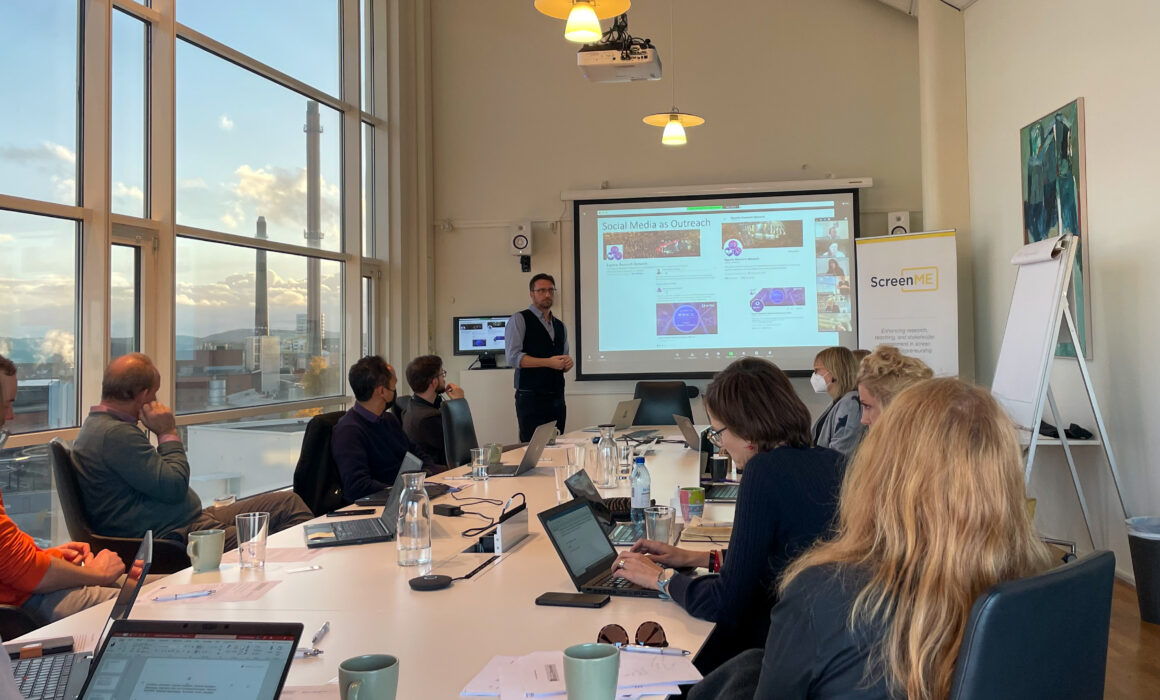How to Enable Long-Term Collaboration between Universities and Societal Actors: A ScreenME Study Visit to the Media, Management, and Transformation Centre
Post written by: Thomas Cyron
The third mission requires well-functioning collaboration between universities and societal actors, such as policy makers and industry practitioners. How can universities enable such collaboration? How can such collaborations work in the long term? The ScreenME project members discussed these questions in a recent study visit to the Media, Management, and Transformation Centre (MMTC) at the Jönköping International Business School. The purpose was to learn from each other how we can best enable long-term collaboration with the media industry. Incidentally, it was also the first time that some of the ScreenME partners met face to face – a great experience!
Some of our project members provided input for joint discussions. The speakers included Mart Ots (MMTC), who shared his experiences regarding industry and policy collaboration from several projects. We also had Brian McCauley (MMTC) sharing his experiences about collaborating with the e-sports community and how he manages to maintain relations with the community’s diverse stakeholders. Ulrike Rohn, Külliki Tafel-Viia, and Silja Lassur (Tallinn University) shared their experiences from Tallinn University Centre of Excellence in Media Innovation and Digital Culture (MEDIT) as well as Tallinn University EXU Centre.
Below, I reflect on the three key issues that transpired from our knowledge exchange.
How should we approach stakeholders from the industry?
Practitioners and policy makers appreciate the role and status of universities in society. Universities are regarded as knowledge strongholds that remain unbiased and can offer a valuable outsider’s point of view. Therefore, they must meet their collaborators at eye level and contribute their unique value-adding perspective in a way that can enhance the understanding of all stakeholders. When this happens, practitioners appreciate theory instead of being alienated by it. They also become more open to being challenged in their prevalent assumptions, which is something that universities seem capable of doing and that practitioners appreciate from such collaboration.
It can also be useful to play the role of an authentic community member (or even become one) when meeting collaborators, as demonstrated by MMTC member Brian McCauley. Sharing and supporting the community’s interest, speaking their language, and experiencing their practices ‘from within’ enable unique perspectives that would otherwise remain hidden from more detached research approaches. However, the challenge is to retain a healthy distance that allows researchers to retain their critical perspective when needed. The more the interests of academia and industry blur, the more academia and industry understand each other’s interests and challenges, but it may also become more difficult for the university to fulfil the role of neutral and unbiased partner, which many collaborators appreciate.
How can universities co-create value with industry practitioners?
There are two approaches through which universities can engage with industry stakeholders. First, either party can engage in one-directional value appropriation. Researcher teams can spend limited time with practitioners and then retract from the context to theorise about the studied phenomenon. Similarly, companies can appropriate intellectual property from universities and then commercialise it. Second, universities and practitioners can switch from a unidirectional value appropriation logic to a bidirectional value creation logic. The university and practitioners collaborate in a way that creates tangible outcomes for both parties – that is, research publications and new theories, as well as tangible outcomes for the practitioners (e.g. guided restructuring of the organisation, R&D collaboration).
The second approach seems productive in long-term collaboration because both parties engage in reciprocal value exchange. When setting up collaborations, the involved parties may therefore ask: ‘What value can we exchange and create?’ In some cases, it might require that either party ‘pays it forward’ before being able to benefit in return.
Universities may also become meeting places and thus move beyond more dyadic approaches to collaboration. In some cases, universities have benefited from enabling new connections among practitioners and organisations, which then engaged in mutual collaboration. Here, universities can contribute indirectly to the creation of value at an economic level. Becoming a meeting place for random encounters can also elicit new research projects and ideas, which then benefit from a larger group of involved stakeholders.
How can we mediatize the collaboration?
Research collaboration can also positively affect the reputation of involved parties. But reaping the benefits requires effective communication of projects throughout and beyond individual collaboration projects. Setting up online communication channels (e.g. websites, social media, podcasts) where the university communicates its various research projects represents one potential option for attracting the interest of other collaborators. This also serves as a strong signal to attract new collaborators: if others have managed to collaborate successfully with a university, why shouldn’t we?
It might also be valuable to step away from a project-based communication approach to participate in the co-creation of a knowledge hub for more specialised industries. For instance, McCauley’s active participation in the establishment of an e-sports research network has brought together many stakeholders from universities and the industry to exchange and create knowledge about the growing phenomenon of e-sports. A website functions as a hub for distributing research publications, news, and a podcast. University can benefit from positive reputation by sponsoring and supporting such endeavours.
Despite our fruitful discussions, there remains lots to learn, experience, and accomplish in terms of long-term collaboration with industry stakeholders. We found that many ‘media industries’ are being disrupted. Universities may play a role in assisting media industry stakeholders in their transitions to new business models, the development of new value offerings, and the upholding of democratic and scientific values. It is an important role, which can only be achieved through reflective and long-term collaboration. We hope our insights can inspire those inside and outside of our network to be bold and pioneer more related initiatives.


